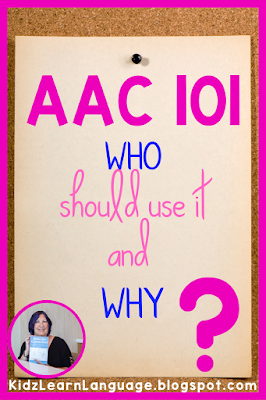All individuals are considered potential candidates for AAC; ASHA and the Joint Commission for Persons with Disabilities have a “zero exclusion” criterion and consider not whether an individual is eligible for services, but rather consider where along the continuum they are currently operating as a starting point . As long as there is a discrepancy between needs and abilities, an individual qualifies for services in AAC.
Best practices also dictate that, while there is a relationship between cognitive and linguistic skills, this is not a causal relationship. Language skills are just as likely to affect cognition as vice versa.
There is no such thing as the typical or average AAC user. You will find individuals who need access to AAC from all age groups and a wide range of diagnostic categories.
There is almost no group of clients or students you will work with where you will not find some need for AAC. Many congenital and acquired disabilities will require the use of AAC. You will find users who have a communication disorder due to a congenital disorder, and those for whom it is acquired; such as aphasia, traumatic brain injury, and ALS.
Children who do not have speech or whose speech is not meeting their communication needs need to be considered as candidates for AAC intervention.
Among children cerebral palsy, Autism Spectrum Disorder and other developmental disabilities probably are the largest groups of AAC users; however, there are a variety of other disabilities or disorders that will require you to think about AAC access. Children with Angelman’s Syndrome, girls with Rett syndrome, developmental apraxia of speech and a host of less common or low-incidence disorders can show up on the SLP’s caseload.
Among adults, cerebral palsy and developmental disabilities continue to be a large group of AAC users. Also adults with ALS, MS, and those who have suffered a stroke/ CVA or spinal cord injury.
In both adults and children traumatic brain injury (TBI) also accounts for too many AAC users.
Not all of these users require high technology AAC systems to communicate. But they do require a robust system that allows them to be effective communicators. The “…ultimate goal of an AAC intervention is not to find a technological solution to the communication problem, but to enable the individual to efficiently and effectively engage in a variety of interactions.” (Beukelman and Mirenda, 1998)
They all also require that there be partners who keep them motivated and stimulated, who provide opportunities for them to communicate, who assess their AAC systems on an on-going bases, and who provided the aided input and modeling needed for them to learn how to use their AAC system and language. These partners also need to know the wide range of communication functions that need to be represented in the users’ toolbox.
As we continue to talk about AAC systems, bear in mind that a functional AAC system is a compilation of strategies that allow the individual to communicate effectively a variety of intents in a variety of contexts, with a variety of partners.




No comments
Post a Comment